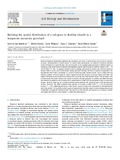Mostrar el registro sencillo del ítem
Relating the spatial distribution of a tall-grass to fertility islands in a temperate mountain grassland
| dc.creator | San Emeterio Garciandía, Leticia | es_ES |
| dc.creator | Durán Lázaro, María | es_ES |
| dc.creator | Múgica Azpilicueta, Leire | es_ES |
| dc.creator | Jiménez, Juan José | es_ES |
| dc.creator | Canals Tresserras, Rosa María | es_ES |
| dc.date.accessioned | 2022-04-12T06:27:02Z | |
| dc.date.available | 2022-04-12T06:27:02Z | |
| dc.date.issued | 2021 | |
| dc.identifier.issn | 0038-0717 | |
| dc.identifier.uri | https://hdl.handle.net/2454/42687 | |
| dc.description.abstract | Plant-soil feedback mechanisms influence the abundance and rarity of plant species and can favour invasive processes, including those of native species. To explore these mechanisms, we analysed correlations between spatial distributions of plant biomass and soil properties in two neighbouring grasslands at different phases of expansion of the native Eurasian tall-grass Brachypodium rupestre (Host) Roem & Schult (B. rupestre cover: >75 and 25–50%). For this, we applied spatially explicit sampling, geostatistical analysis and structural equation models (SEM) to probe causal relationships among measured variables involved in nutrient accumulation. We hypothesized that if litter accumulates as a result of reduced grazing, ‘fertility islands’ (spots of high SOM and nutrient contents) will form under B. rupestre clumps because the increase in resource inputs from litter will trigger SOM build-up and promote microbial growth. Our results show that ‘fertility islands’ of P and amino acids occurred under the patchy clumps of B. rupestre in the less invaded grassland. In addition, the SEMs indicated that nutrient accumulation was partially due to mineralization of the SOM and modulated by the soil microbial biomass. However, there was no correlation between spatial patterns of B. rupestre biomass, SOM and microbial biomass. Moreover, the SEMs explained small amounts of variance in them (SOM r2 = 0.22 and microbial biomass r2 = 0.08), suggesting that factors other than B. rupestre biomass were responsible for the high fertility below the patches. Our spatially explicit approach demonstrated that litter inputs in dense temperate grassland communities can generate ‘fertility islands’ that may favour the stability and expansion of a tall-grass invader and suggest that herbivory may enhance or inhibit this phenomenon. | en |
| dc.description.sponsorship | The study was funded by ‘la Caixa’ Foundation, Spain and CAN foundation, Spain (LCF/PR/PR13/51080004), the Ministry of Science and Innovation of the Spanish Government (project refs. CGL2010-21963, CGL2011-29746 and CGL2017-85490-R), and Interreg Sudoe Programme, European Regional Development Fund, European-Union, Open2preserve Project (SOE2/P5/E0804). L. Múgica and M. Durán were funded through a UPNA Research Staff Training Grant. | en |
| dc.format.extent | 12 p. | |
| dc.format.mimetype | application/pdf | en |
| dc.format.mimetype | application/zip | en |
| dc.language.iso | eng | en |
| dc.publisher | Elsevier | en |
| dc.relation.ispartof | Soil Biology and Biochemistry, 163 | en |
| dc.rights | © 2021 The Authors. Creative Commons Attribution-NonCommercial-NoDerivatives 4.0 International | en |
| dc.rights.uri | http://creativecommons.org/licenses/by-nc-nd/4.0/ | |
| dc.subject | Brachypodium rupestre | en |
| dc.subject | Fertility island | en |
| dc.subject | Geostatistics | en |
| dc.subject | Native invader | en |
| dc.subject | Soil function | en |
| dc.title | Relating the spatial distribution of a tall-grass to fertility islands in a temperate mountain grassland | en |
| dc.type | Artículo / Artikulua | es |
| dc.type | info:eu-repo/semantics/article | en |
| dc.contributor.department | Institute on Innovation and Sustainable Development in Food Chain - ISFOOD | es_ES |
| dc.contributor.department | Agronomía, Biotecnología y Alimentación | es_ES |
| dc.contributor.department | Agronomia, Bioteknologia eta Elikadura | eu |
| dc.rights.accessRights | info:eu-repo/semantics/openAccess | en |
| dc.rights.accessRights | Acceso abierto / Sarbide irekia | es |
| dc.identifier.doi | 10.1016/j.soilbio.2021.108455 | |
| dc.relation.projectID | info:eu-repo/grantAgreement/MICINN//CGL2011-29746/ES/ | en |
| dc.relation.projectID | info:eu-repo/grantAgreement/AEI/Plan Estatal de Investigación Científica y Técnica y de Innovación 2013-2016/CGL2017-85490-R/ES/ | en |
| dc.relation.publisherversion | https://doi.org/10.1016/j.soilbio.2021.108455 | |
| dc.type.version | info:eu-repo/semantics/publishedVersion | en |
| dc.type.version | Versión publicada / Argitaratu den bertsioa | es |
| dc.contributor.funder | Universidad Pública de Navarra / Nafarroako Unibertsitate Publikoa | es |



